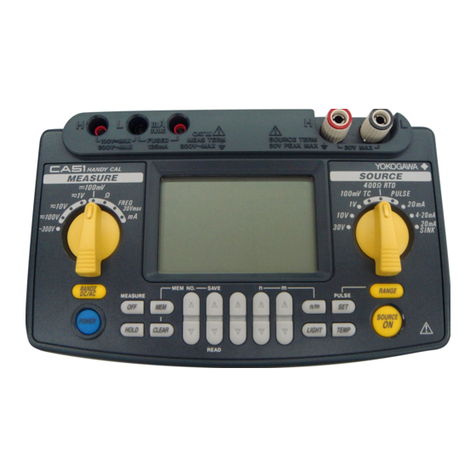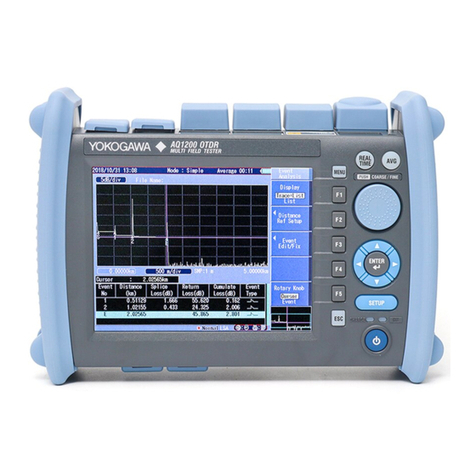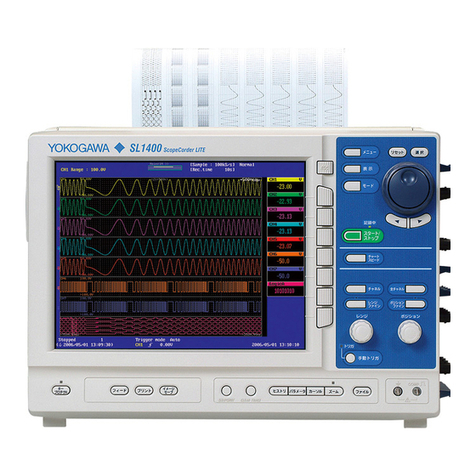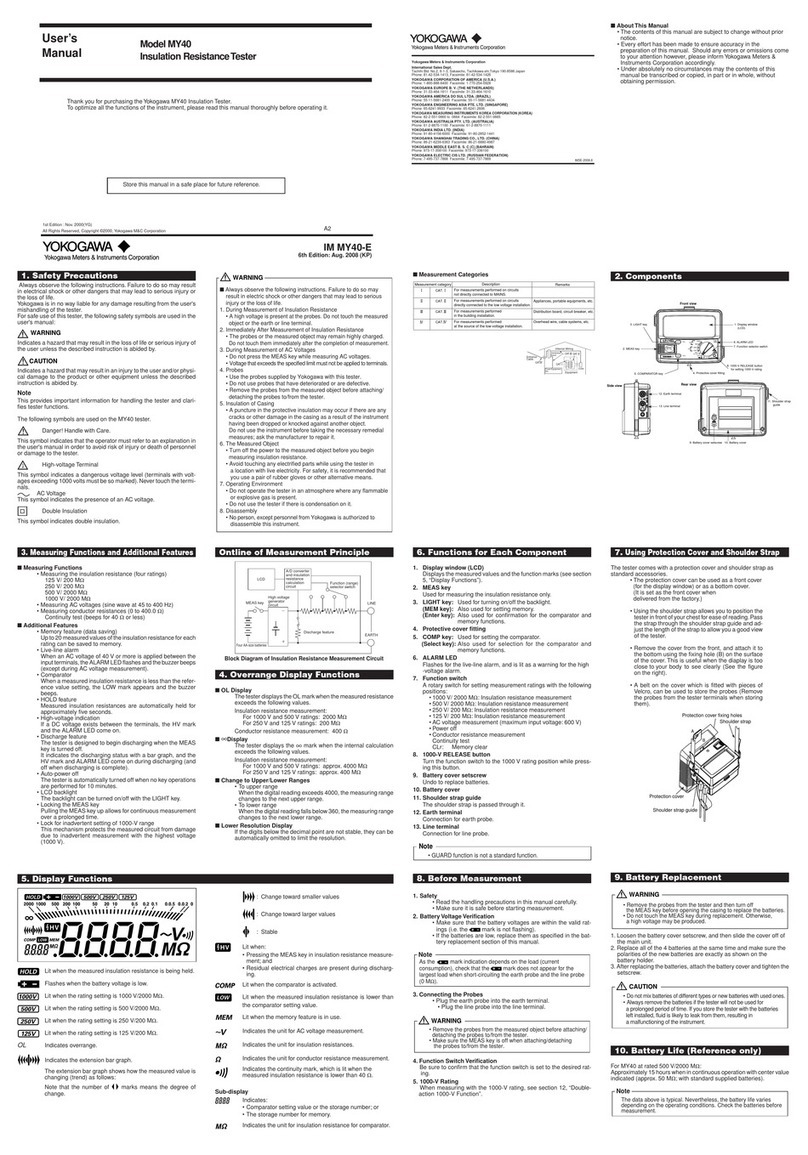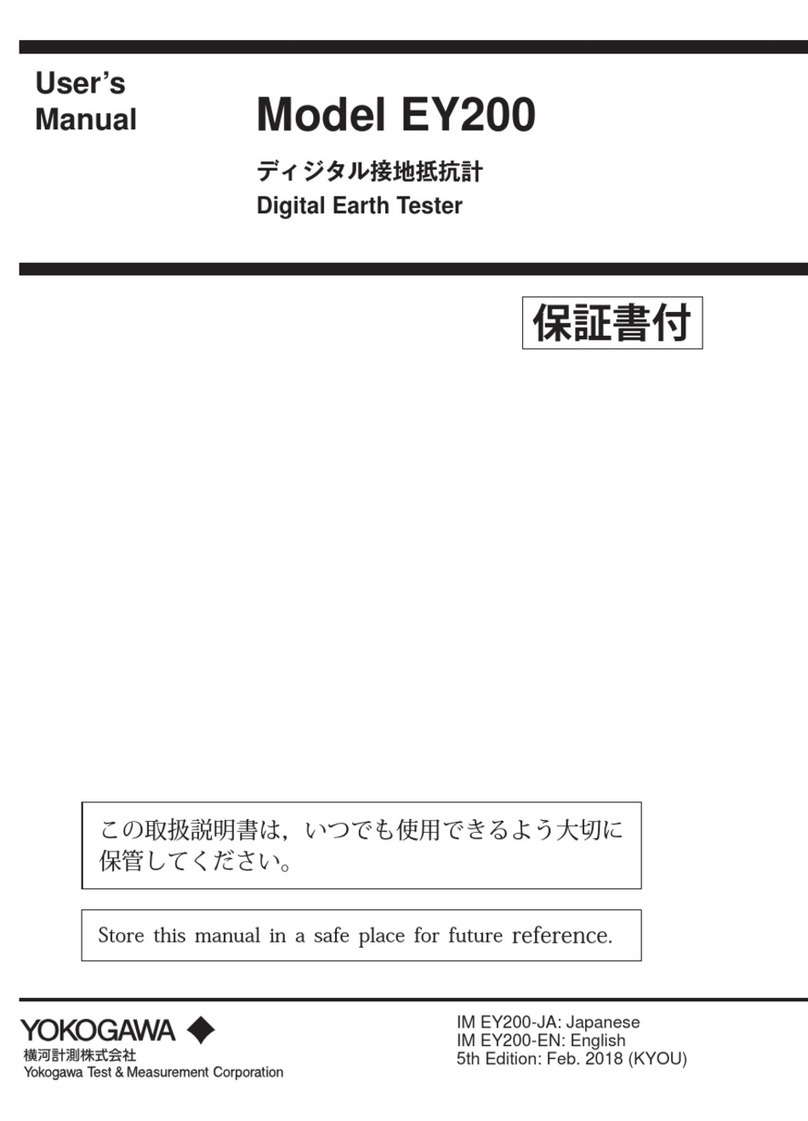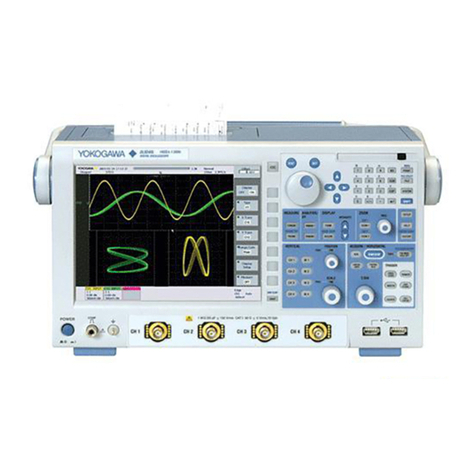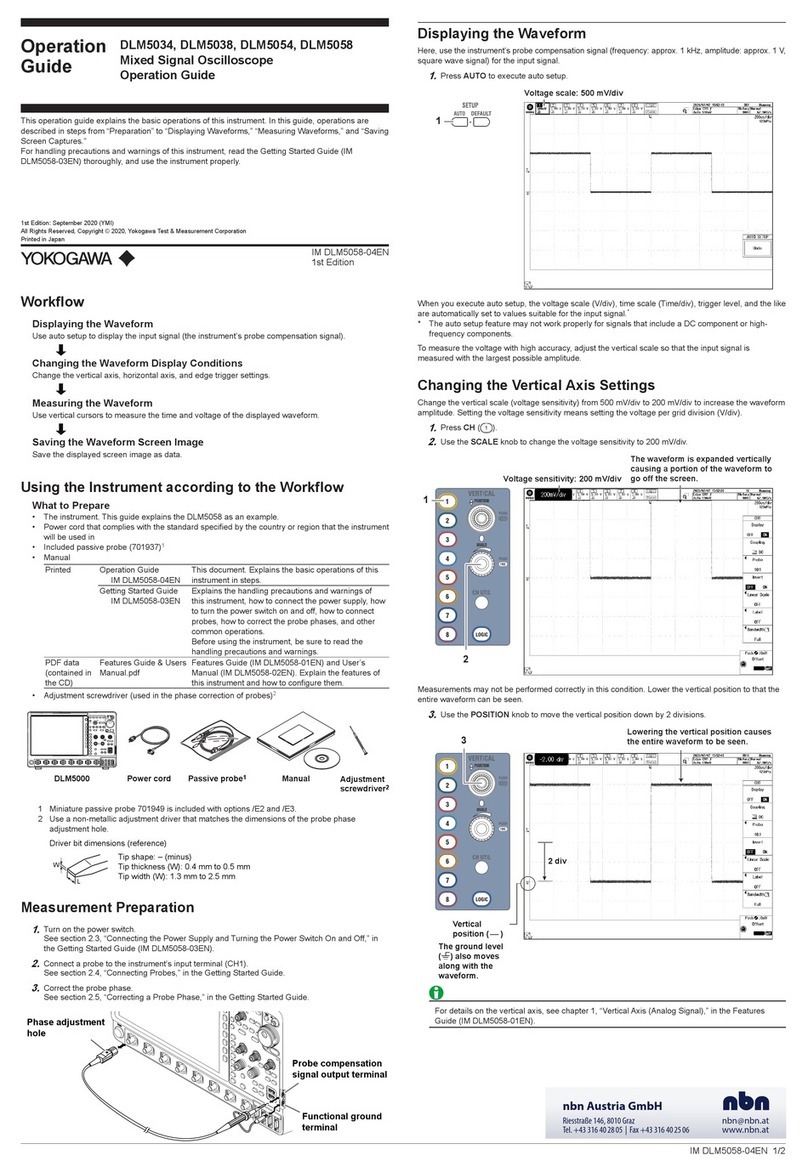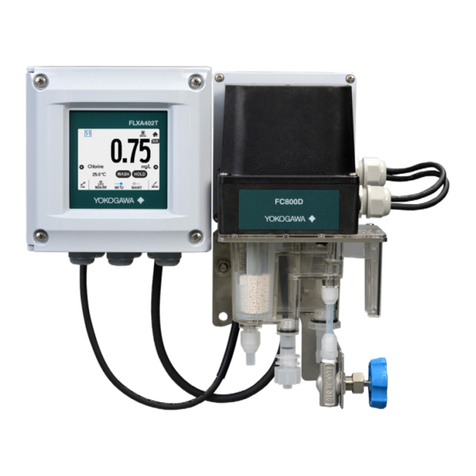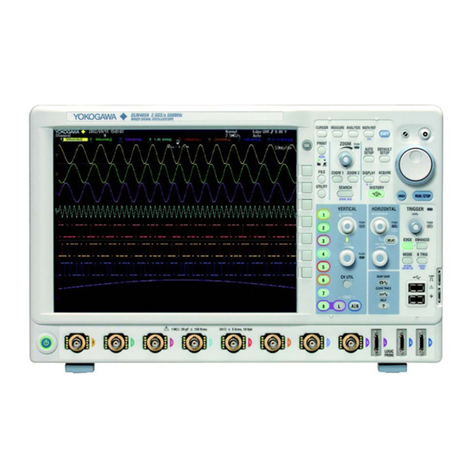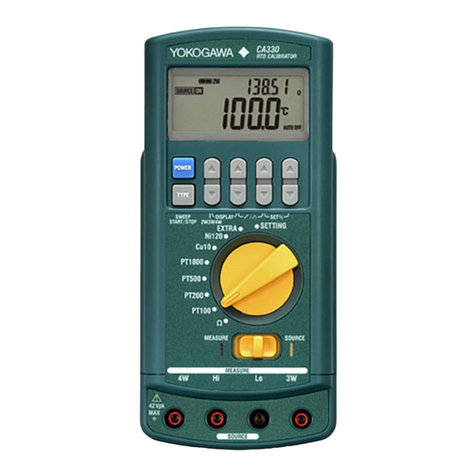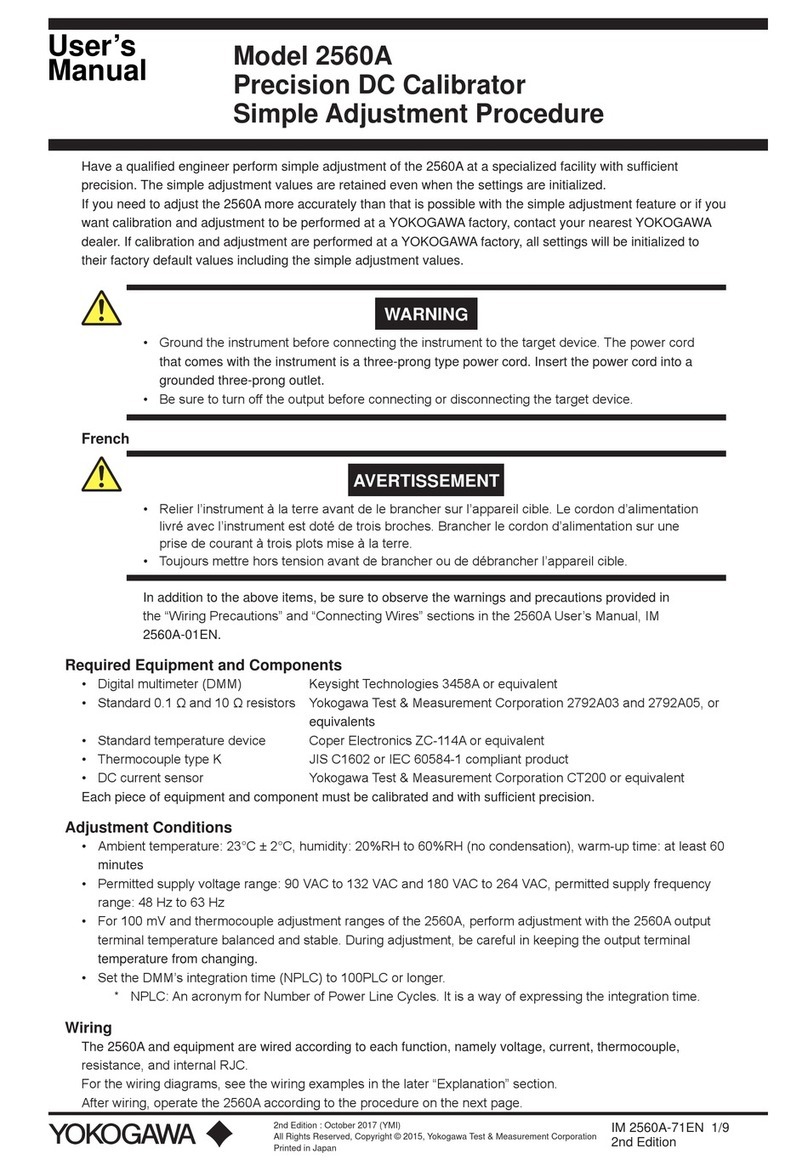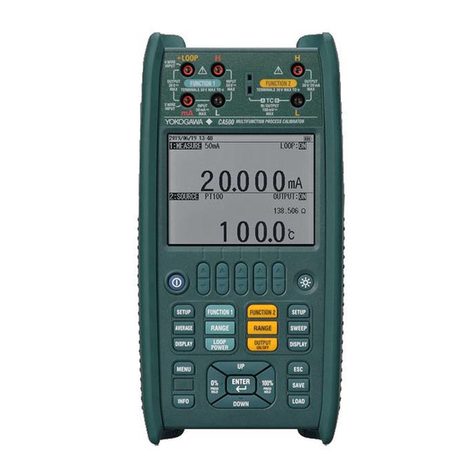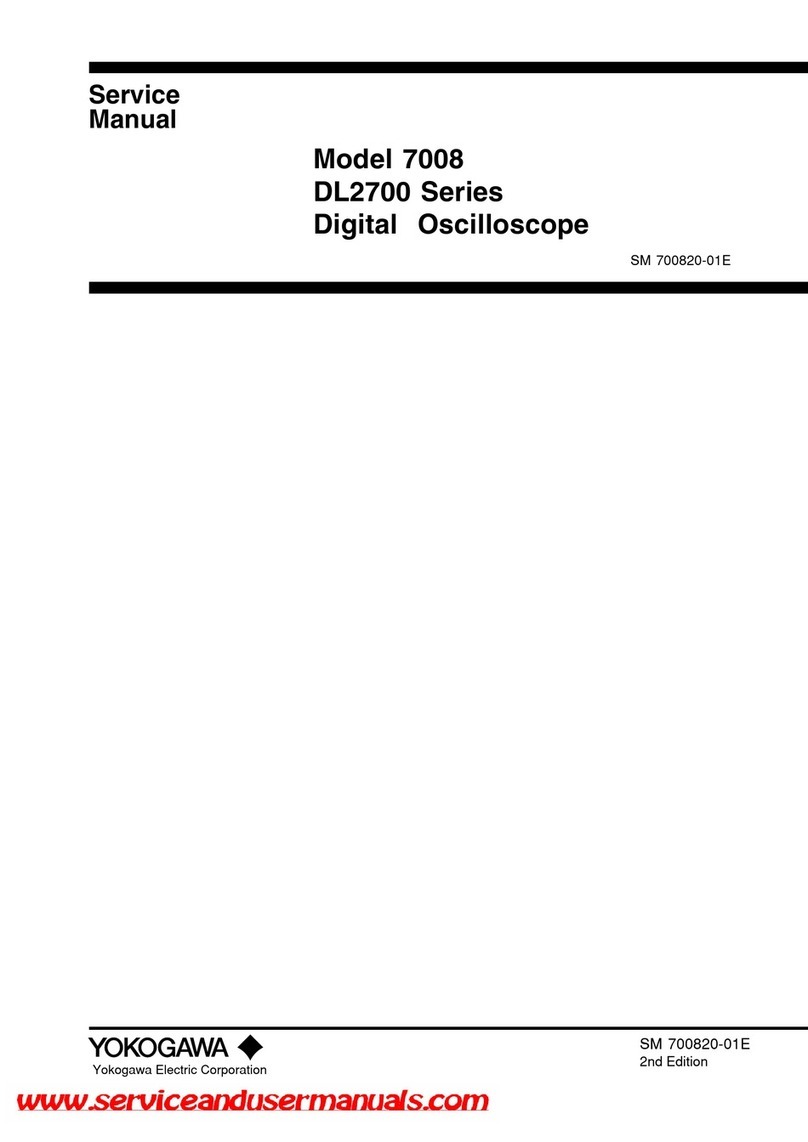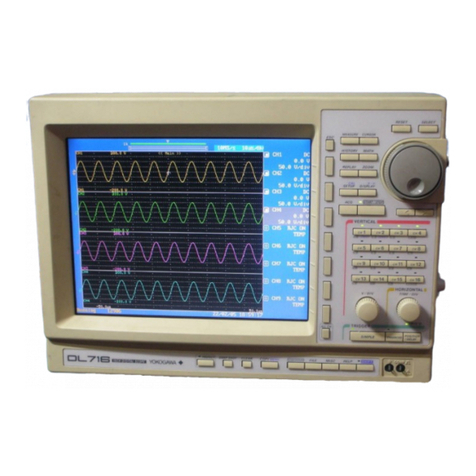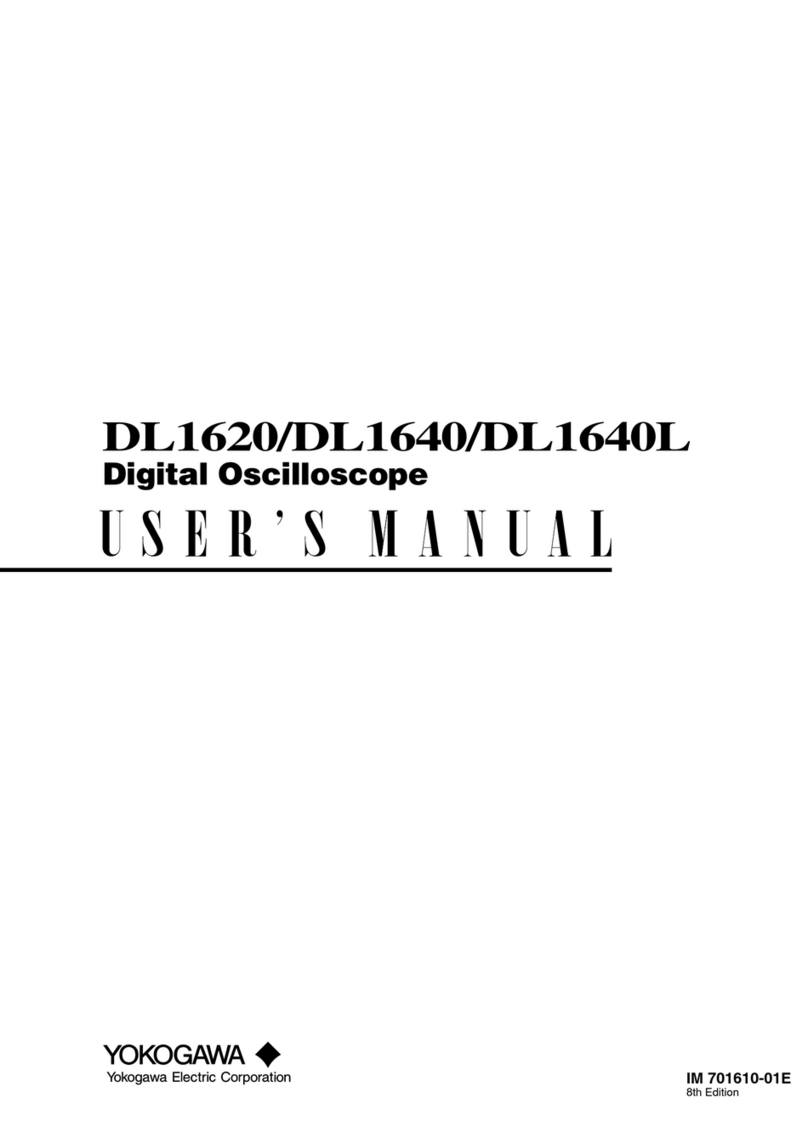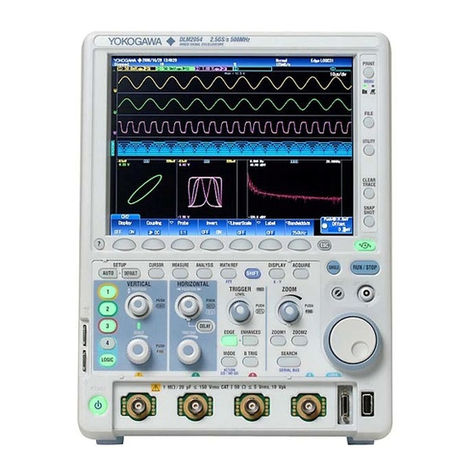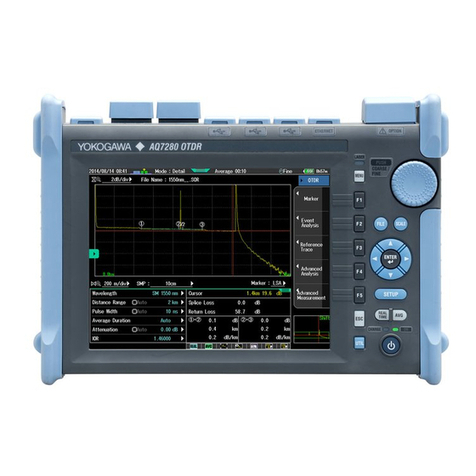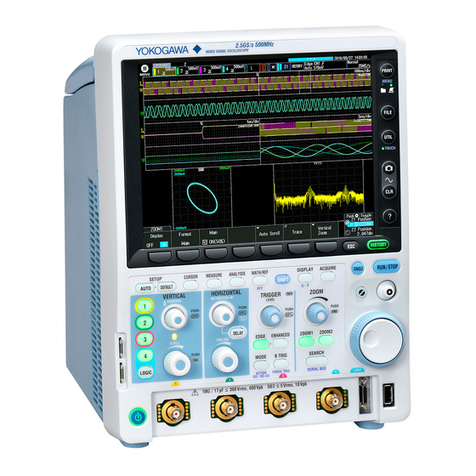
French
ATTENTION
N’appliquez pas une force excessive sur la vis de réglage de phase. Cela pourrait
endommager le condensateur variable interne.
1.
Connect the BNC connector of the probe to the input of the oscilloscope, and connect the probe
input to the oscilloscope signal output terminal for probe compensation adjustment (CAL or
COMP terminal).
2.
Operate the vertical and time scales on the oscilloscope, and turn the phase adjustment screw
with the included adjustment screwdriver to adjust the observed waveform to the correct
waveform (square wave). Adjust the probe capacitance to match the input capacitance of the
oscilloscope with the variable capacitor inside the probe.
Over Compensation Inadequate CompensationCorrect Waveform
Note
Accurate measurements may not be possible near objects with strong electromagnetic fields such
as transformers, large current circuits, or wireless equipment.
4. Specifications
Item Specifications
Probe length 2500 mm ±50 mm (including the pincher tip)
Connector type BNC (with the probe ID pin)
Attenuation ratio 10:1 ±2 % (+5 °C to +40 °C)1
10:1 ±3 % (−40 °C to +5 °C, +40 °C to +85 °C)1
Frequency band DC to 200 MHz (−3 dB)2
Rise time 1.8 ns (typical)2,3
Propagation delay time 12.0 ns (typical)3
Maximum input voltage ±1000 V (DC + ACpeak)4
Input resistance 10 MΩ ±2 %1
Input capacitance 16.0 pF (typical)3
Matching input capacitance 15 pF to 25 pF
Operating
environment
Temperature/Humidity −40 °C to +85 °C (no condensation)5
However, up to +40 °C on the phase adjustment unit
Altitude 3000 m or less
Storage
environment
Temperature/Humidity −40 °C to +85 °C (no condensation)5
Altitude 4600 m or less
Compliant
standards
Safety standard EN 61010-031
Measurement category II6 1000 V (DC + ACpeak)
Pollution degree 27
Environmental standards8EU RoHS Directive compliant
1 In combination with an oscilloscope with an input impedance of 1 MΩ ±1%.
2 Varies depending on the oscilloscope combined.
3 “Typical” values are typical or average values and are not strictly guaranteed.
4 Complies with safety standard EN 61010-031 (see “Safety standards”). And input voltage
derating by frequency applies (see the figure below).
5 Temperature/humidity derating applies. See the figure below for humidity.
6 The product is for measurement category II (CAT II). Do not use it with measurement category
III (CAT III), nor measurement category IV (CAT IV). When using devices or accessories with
different measurement categories, the lower measurement category applies. See below for
definitions of measurement categories.
Measurement Category Definition
Measurement category “O (Other)” Measurement category O (Other) applies to
measurement of a circuit that is not connected directly
to the main power source.
Measurement category II (CAT II) CAT II applies to measurement of electrical equipment
that is powered through a fixed installation such
as a wall outlet wired to a distribution board and
measurement on such wiring.
Measurement category III (CAT III) CAT III applies to measurement at the distribution level,
that is, building wiring, fixed installations.
Measurement category IV (CAT IV) CAT IV applies to measurement at the primary supply
level, that is, overhead lines, cable systems.
7 Pollution degree applies to the degree of adhesion of a solid, liquid, or gas which deteriorates
withstand voltage or surface resistivity. Pollution Degree 2 applies to normal indoor atmospheres
(usually with only non-conductive pollution).
8 For conformity to environmental regulations and/or standards other than EU, contact your
nearest Yokogawa office (PIM 113-01Z2).
Input Voltage Derating by Frequency and Temperature/humidity Derating
WARNING
As the frequency of the input signal increases, the maximum input voltage of the probe
decreases.
French
AVERTISSEMENT
Lorsque la fréquence du signal d’entrée augmente, la tension d’entrée maximale de la sonde
diminue.
20.2 V
Input Voltage Derating by Frequency
10000
1000
100
10
Frequency [MHz]
Maximum input voltage [V]
0.01 0.1 1 10 100200
90
80
70
60
50
40
30
20
10
09080706050403020100 100
Temperature vs. Humidity Derating
Temperature [°C]
11.6 %RH
85
Temperature Cycle Reference Values
It has been verified that the probe can withstand at least 500 repetitions of the following temperature
cycle in a resting state. However, these are reference values and are not strictly guaranteed.
+85
−40
0
[min]
40 min to 50 min
> 30 min
80 min to 90 min
> 5 min
1
2
3
4
−40°C to +85°C:
+85°C:
+85°C to −40°C:
−40°C:
One cycle duration
3. How to Use
WARNING
• Use this probe only with YOKOGAWA’s oscilloscopes. Even with YOKOGAWA’s
oscilloscopes, this probe can be used only when specified as a connectable accessory.
Also, use this probe only with standard accessories or optional accessories sold
separately.
• When connecting the probe to the object under measurement, be careful of electric
shock, burns, and frostbite.
• Do not apply a voltage exceeding the maximum input voltage to the probe. EN 61010-
031 is a safety standard that applies to the probe alone. For the actual compliant safety
standards and operating conditions, observe the conditions for the oscilloscope. Failure
to observe them may cause accidents, such as electric shock and damage to the
instrument.
• When the oscilloscope’s input coupling is AC, a DC voltage is applied to the
oscilloscope’s input at the same electric potential as the probe’s input. Make sure not to
exceed the oscilloscope’s maximum input voltage.
• This probe cannot be used to measure the voltage between two points floating from the
ground potential. Consider using a differential probe.
• After use, turn off the power to the device under measurement, disconnect the probe from
the device under measurement, and then disconnect the probe from the oscilloscope.
CAUTION
• When using optional tip accessories (such as alligator clip adapters) sold separately,
make sure to use the 4Φ conversion adapters sold separately in between. Optional tip
accessories are unavailabe without the 4Φ conversion adapters.
• When connecting the probe tip directly to the device under measurement without using
the attached pincher tip or optional accessories, use 40 V or less.
• The product is not dust proof or water resistant. Do not use the product in areas with a lot
of dust or where water may be spilled.
• Avoid using or storing the product in an environment that does not meet the specifications
such as under direct sunlight, high temperature, high humidity, or where condensation
may form. Deformation and insulation deterioration can occur to cause the probe to no
longer meet the specifications.
• Avoid vibration, shock, and static electricity when handling the probe. Do not bend or pull
the cables excessively. Doing so may damage or disconnect the probe.
• When cleaning the probe, wipe with a piece of soft cloth to prevent damaging the probe.
Do not immerse the probe body in liquid. Do not use abrasive cleaners or volatile solvents
such as benzine on the probe.
French
AVERTISSEMENT
• Utilisez la sonde uniquement avec les oscilloscopes de YOKOGAWA. Même avec les
oscilloscopes de YOKOGAWA, la sonde ne peut être utilisée que si spécifiée comme
accessoire connectable. Et utilisez la sonde uniquement avec des accessoires standard
ou des accessoires en option vendus séparément.
• Lors de la connexion de la sonde à l’objet faisant l’objet de la mesure, faire attention au
choc électrique, aux brûlures et aux gelures.
• N’appliquez pas une tension supérieure à la tension d’entrée maximale sur la sonde.
EN61010-031 est une norme de sécurité conforme qui s’applique à la sonde seule. Pour
les normes de sécurité et les conditions d’utilisation actuelles, suivez les conditions de
l’oscilloscope. Si cette précaution n’est pas prise, des accidents tels qu’un choc électrique
ou un dégât matériel peuvent se produire.
• Lorsque le couplage d’entrée de l’oscilloscope est AC, une tension DC est appliquée à
l’entrée de l’oscilloscope au même potentiel électrique que l’entrée de la sonde. Assurez-
vous de ne pas dépasser la tension d’entrée maximale de l’oscilloscope.
• La sonde ne peut être utilisée pour mesurer la tension entre deux points flottant du
potentiel de terre. Pensez à utiliser une sonde différentielle.
• Après utilisation, coupez l’alimentation de l’appareil en cours de mesure, déconnectez la
sonde de l’appareil en cours de mesure, puis déconnectez la sonde de l’oscilloscope.
ATTENTION
• Lorsque vous utilisez des accessoires de pointe en option (tels que des adaptateurs
de pince crocodile) vendus séparément, assurez-vous d’utiliser les adaptateurs de
conversion 4Φ vendus séparément entre les deux. Les accessoires de pointe en option
ne sont pas disponibles sans les adaptateurs de conversion 4Φ.
• Lorsque vous connectez la pointe de la sonde directement à l’appareil sous mesure sans
utiliser la pointe de pince attachée ou les accessoires en option, utilisez 40 V ou moins.
• Le produit n’est pas étanche à la poussière ni à l’eau. N’utilisez pas le produit dans des
zones très poussiéreuses ou dans lesquelles de l’eau pourrait être renversée.
• Évitez d’utiliser ou de stocker le produit dans un environnement qui ne répond pas aux
spécifications, par exemple sous la lumière directe du soleil, à des températures élevées,
à une humidité élevée ou là où de la condensation peut se former. Une déformation et
une détérioration de l’isolation peuvent survenir, faisant que la sonde ne répond plus aux
spécifications.
• Évitez les vibrations, les chocs et l’électricité statique lors de la manipulation du produit.
Ne pliez pas et ne tirez pas les câbles de manière excessive. Cela pourrait endommager
ou déconnecter la sonde.
• Lors du nettoyage de la sonde, essuyez avec un morceau de chiffon doux pour éviter
d’endommager la sonde. Ne plongez pas le corps de la sonde dans un liquide. N’utilisez
pas de nettoyants abrasifs ni de solvants volatils tels que la benzine sur la sonde.
How to Connect
1.
Connect the BNC connector of the probe to the input of the oscilloscope with the input
impedances of 1 MΩ. Set the input impedance of the oscilloscope to 1 MΩ.
2.
The probe ID pin is automatically detected, and the oscilloscope attenuation ratio is automatically
set to 10:1. If it is not set automatically, set it manually.
3.
Depending on the object under measurement or the situations, connect the attached pincher tip
and safety ground lead to the tips of the probe, or connect the optional accessories by putting
the optional 4Φ conversion adapters (signal end / ground) in between. See Connecting the
Optional Accessories for details.
4.
Adjust the phase of the probe using the screwdriver. See Phase Adjustment for details.
Connecting the Optional Accessories
If you use the optional 4Φ conversion adapters (signal end B8099NL / ground B8099NM, 1000
Vpeak CAT II) instead of the attached pincher tip (B8099MR) and safety ground lead (B8099NK),
you can connect to the following optional tip accessories. We offer a variety of combinations.
Contact your nearest YOKOGAWA dealer for details.
• Pincher tip (B9852MN/B9852MM, rated 1000 Vrms CAT III)
• Alligator clip adapter (758929, rated 1000 Vrms CAT II)
• Fork terminal adapter (758921, rated 1000 Vrms CAT II)
Alligator clip adapter
(red)
4Φ conversion adapter (signal end)
4Φ conversion adapter (ground)
Alligator clip adapter (black)
Connection example with accessories
Phase Adjustment
CAUTION
Do not apply excessive force to the phase adjustment screw. Doing so may damage the
internal variable capacitor.
IM 702906-01EN 2/2

